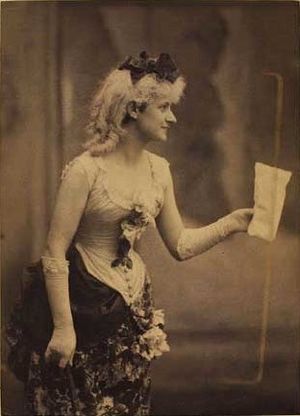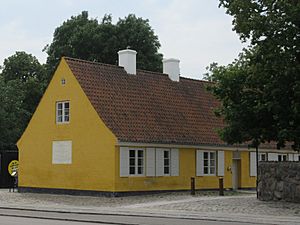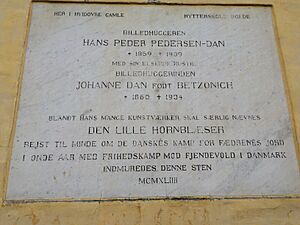Johanne Pedersen-Dan facts for kids
Quick facts for kids
Johanne Pedersen-Dan
|
|
|---|---|

Fotografi fra 1880-årene. Det Kgl. Bibliotek
|
|
| Born | 13 May 1860 Copenhagen |
| Died | 21 May 1934 Hvidovre |
| Resting place | Hvidovre Cemetery |
| Occupation | Sculptor |
| Spouse(s) | Hans Peder Pedersen-Dan |
| Parent(s) | |
| Awards | |
Johanne Agnete Theresia Pedersen-Dan (born Betzonich, 1860–1934) was a talented Danish artist. She was an actress and singer, but later became a famous sculptor. She often showed her amazing artwork at Charlottenborg in Copenhagen. Johanne and her husband, Hans Peder Pedersen-Dan, who was also a sculptor, lived and worked in a special building called Hvidovre Rytterskole in Hvidovre from 1912 to 1936.
Contents
Early Life and Family
Johanne was born in Copenhagen, Denmark, on May 13, 1860. Her full name was Johanne Agnete Theresia Betzonich. Her father was Georg Betzonich, a writer, and her mother was Christiansine Nicoline Møller.
Becoming an Actress
Johanne Pedersen-Dan started her career as an actress. Her cousin, Elga Sinding, who was a successful actress, encouraged her. Johanne first performed in 1876 at the Folketeatret (a theatre in Copenhagen). She played the baroness in a play called Familien Danielsen.
She continued to act in many plays and operettas. An operetta is like a short, light opera. One famous show she was in was Offenbach's La Vie parisienne. She also performed at other well-known theatres, including the Casino Theatre and the Dagmar Theatre.
A New Path: Sculpture
After her acting career, Johanne decided to try something new: sculpture. She began to study sculpture with Stephan Sinding, who was her cousin's husband. In 1890, she showed her very first sculpture at the Charlottenborg Spring Exhibition. It was a shiny sculpture of a female snake charmer.
In 1892, Johanne married Hans Peder Pedersen-Dan, who was also a sculptor. They shared a love for art and often traveled together.
Exhibitions and Awards
Johanne's sculptures were shown in many important places. She had her work at the 1895 Copenhagen Women's Exhibition. Her art was also displayed in Munich, Germany, in 1892, 1909, and 1913. She even showed her work at the World's Columbian Exposition in Chicago, USA, in 1893. This was a very big world's fair!
In 1903, Johanne won a special award called the Neuhausen Prize for her small statue called Little Mother. This was a great achievement!
In 1906, she won an international competition. She designed an emblem (a symbol) that supported women's right to vote. This emblem became very popular and was used in both Europe and the United States.
Life and Work in Hvidovre
Johanne and her husband loved to travel and learn about art from different places. They went on many trips, especially to Paris, France, and Italy. They even visited North Africa in 1904.
From 1912 to 1936, the couple lived and worked in a building that used to be a cavalry school in Hvidovre. This was a special place where they could create their art. Johanne was also a board member of the Danish Sculptors Society, which means she helped lead other sculptors.
Personal Life and Legacy
Johanne and Hans Peder Pedersen-Dan adopted a girl named Rigmor. Johanne Pedersen-Dan passed away on May 21, 1934, when she was 74 years old. She is buried at Hvidovre Cemetery.
Today, you can find a special plaque on one of the walls of Hvidovre Rytterskole. This plaque reminds everyone that Johanne Pedersen-Dan and her husband lived and created their art in that building for many years.
List of Notable Sculptures
Here are some of Johanne Pedersen-Dan's well-known sculptures:
- Snake charmer (made of plaster, 1890)
- By the Stream (made of plaster, 1891)
- A Forest Nymph (made of plaster, 1892)
- After the Storm (made of plaster, 1894)
- Woman Sleepwalker (1902)
- Little Mother (1903)
- Santa (made of plaster, 1905)
- Forest Idyll (made of bronze, 1898)
- On the Slave Market (1006)



